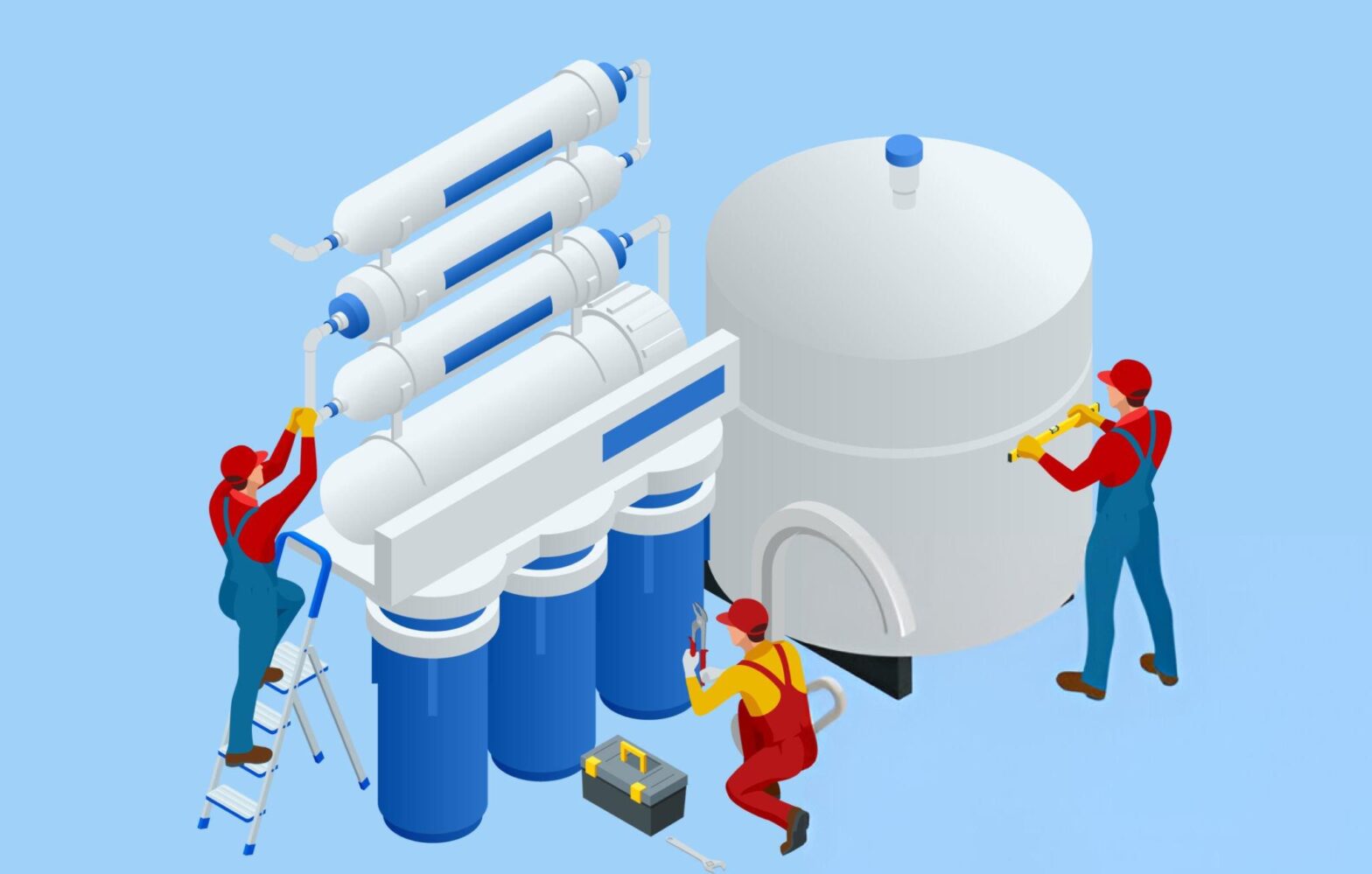Introduction to Reverse Osmosis Filters
Did you know that the real workhorses that produce the crisp, refreshing water you enjoy almost every day are usually reverse osmosis filters?
They are used to filter out contaminants and impurities from bottled water to desalination plants. There are actually various filters at the heart of every reverse osmosis system that ultimately purifies your water through a pressure-driven process that forces water molecules through a semi-permeable membrane.
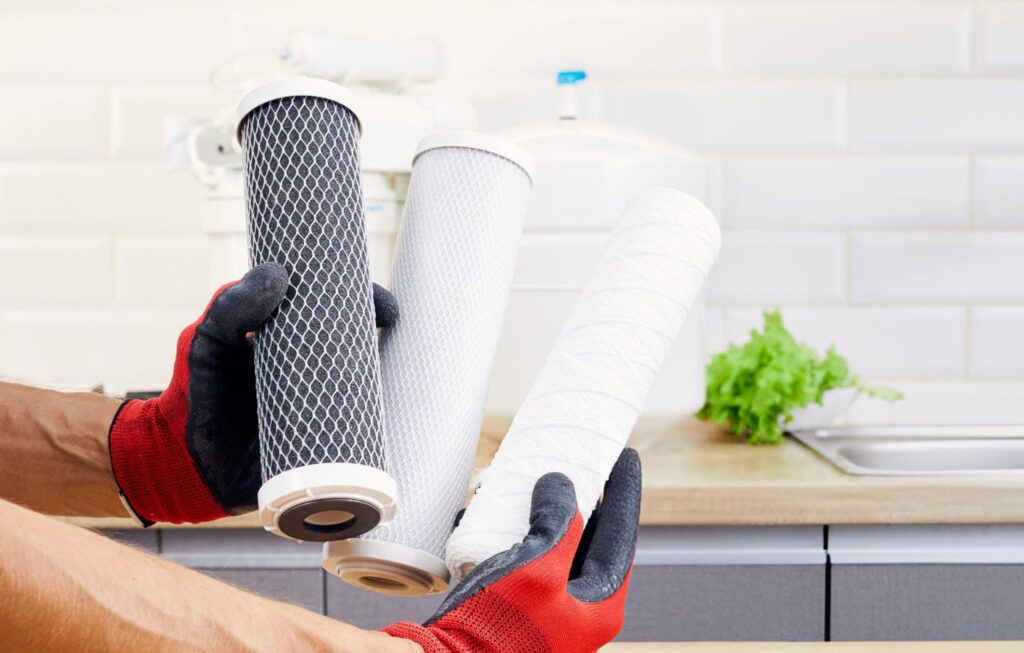
This nearly magical membrane filters out all sorts of tiniest contaminants, minerals, and substances, delivering water that’s not just clean, but downright delicioso (that’s delicious in English)!
But here’s the thing: filters don’t last forever. They get used up, worn out, and clogged with the exact stuff you want to remove. Knowing when to replace your reverse osmosis filters is key to keeping them in top-notch condition.
Several factors play into their lifespan, including how much water you use, the quality of the water that goes in, and the type of filters in your system. Regular maintenance and timely filter replacements ensure that you always have access to safe, pure, and tasty water straight from your tap. 🚰
Underlying Technology of Reverse Osmosis
Alright, let’s get into the poly hose and compression fittings (nuts and bolts) of how reverse osmosis (RO) works, shall we? At the heart of any reverse osmosis system are a few key components: the pre-filter, carbon filter, sediment filter, and, of course, the all-important semi-permeable membrane.
In most residential systems, each of the filters are inside housings connected together with poly-urethane hose and compression fittings.
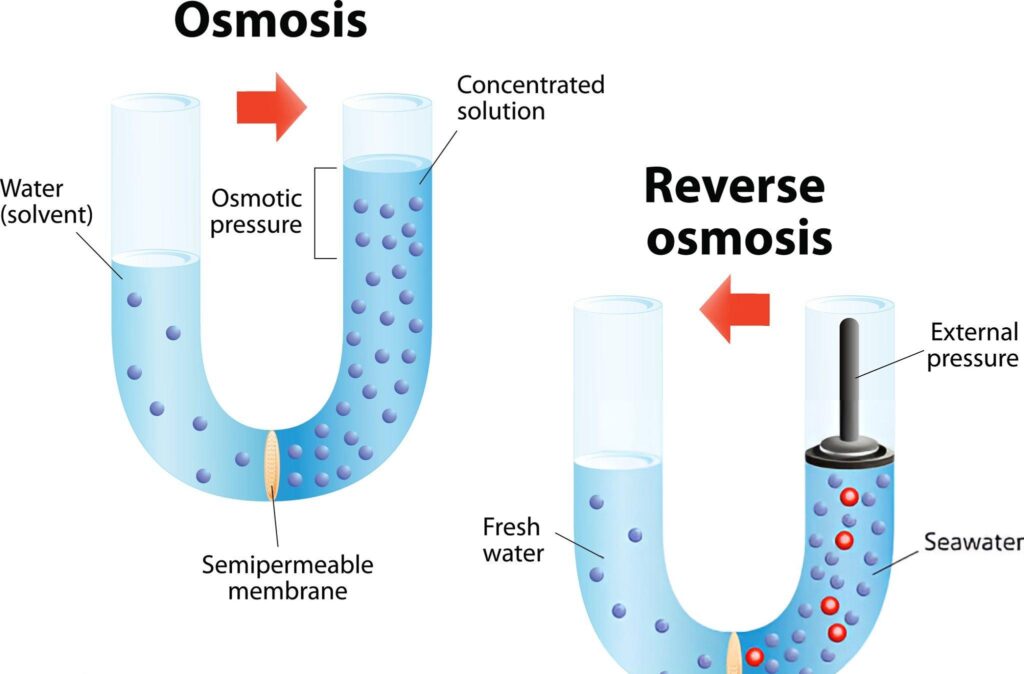
Starting with the pre-filter, the unsung hero that takes on the big stuff like sediment and large particles, making sure the more delicate filters downstream don’t get clogged up.
Teaming up with the pre-filter is the carbon filter, which is essential for knocking out chlorine and other nasties that could harm the semi-permeable membrane—the true star of the show.
The semi-permeable membrane is where the magic really happens, this is what puts the reverse into reverse osmosis. But what is that exactly?
Osmosis is when a concentrated aqueous solution is separated from a less concentrated aqueous solution or pure water by a semi-permeable membrane. Which is to say, there is a filter that only allows water molecules to pass between the two solutions, hence it is “semi” – permeable. If it was just permeable, all liquids would pass through. So in osmosis the water molecules will naturally want to move into the more concentrated side and balance the concentration levels.
In reverse osmosis, pressure is applied to the concentrated side to force the water molecules through the semi-permeable membrane. This results in pure water being filtered out of a concentrated aqueous solution, like sea water or tap water. Pressure is the key, and if your water supply doesn’t provide enough pressure, you can get a reverse osmosis booster pump to increase the water pressure.
Since the RO Membrane only allows water molecules pass through, is leaves most dissolved solids behind the waste water. Here’s another tip, RO Membranes filter water faster with warm water, so try hooking it up to your hot water instead for better performance.
The performance and lifespan of your precious RO system relies mainly on this hardworking membrane. And it lasts longer when the other filters are well replaced frequently.
So, understanding these components is key to knowing how long your reverse osmosis filters will last and how well they’ll keep delivering that clean, fresh water we all love. Let’s dig deeper into the specifics and ensure your system runs smoothly for years to come.
Factors Influencing the Life of Reverse Osmosis Filters
The key factor is water quality. If your water is packed with impurities like suspended solids, bacteria, and minerals, you might find yourself doing more frequent filter replacements. Sure, pre-filters help tackle these contaminants, but if the water’s too dirty, it can still shorten the lifespan of your RO filter.

To keep your RO system running smoothly, regular maintenance is a must. This includes timely cleaning and replacing filters to ensure everything functions at its best.
And don’t forget about environmental factors like temperature, pH level, and pressure—they all play a part in how long your filters keep doing their thing. With proper care and attention, your RO system can provide you with clean, fresh water for a long time.
Material Used
The lifespan of reverse osmosis (RO) systems largely depends on the materials used in their filters. There are two main types of filters: pre-filters and the RO membrane itself. Pre-filters, often a sediment filter and a carbon filter.
The sediment filters are commonly made from a variety of materials like, paper, polypropylene, polyester, or many other things. The carbon filter is often filled with activated carbon. Both trap larger impurities like sediment and chlorine.
The carbon filter also tackles organic compounds, enhancing taste and odor while shielding the RO membrane from chlorine damage. The RO membrane, typically made from thin-film composite, is the heavy lifter, removing the tiniest contaminants. Its selective permeability lets only water molecules through, keeping unwanted substances out. Quality, maintenance, and the water quality itself all significantly impact these filters’ lifespan.
Frequency of Use
How often you use your reverse osmosis system—basically, your water usage—plays a big role in filter longevity. If you’re running the system frequently for drinking, cooking, and other needs, the filters will wear out faster. The more water that flows through the system, the more wear and tear you put on the filters.
Over time, this consistent use decreases their efficiency in removing contaminants, leading to the need for replacements. So, water usage is a key factor in determining how long your RO filters will last. You can get an inline water meter to help keep track of the volume of water filtered, so you can replace the filters at the right time.
Quality of Water Filtered
The quality of the water you filter through your reverse osmosis system affects its lifespan massively. RO systems excel at removing dissolved and suspended substances, making them popular for purifying drinking water. They filter out impurities as small as 0.0001 microns, resulting in clean and safe water free from harmful substances like lead and fluoride.
However, the effectiveness and longevity of an RO filter depend heavily on the incoming water quality, the frequency of filter changes, and proper maintenance. Keep these factors in check to ensure your system runs efficiently for a long time.
The Expected Lifespan of Reverse Osmosis Filters
So, how long do reverse osmosis (RO) filters actually last? Well, it mainly depends on how often you use them and the quality of the water you’re filtering. Generally, standard filters need to be replaced every six to twelve months.
However, if you have a higher-end model, you might get up to two years before needing a change. It’s crucial to know when to swap out those filters to keep your water consistently pure.
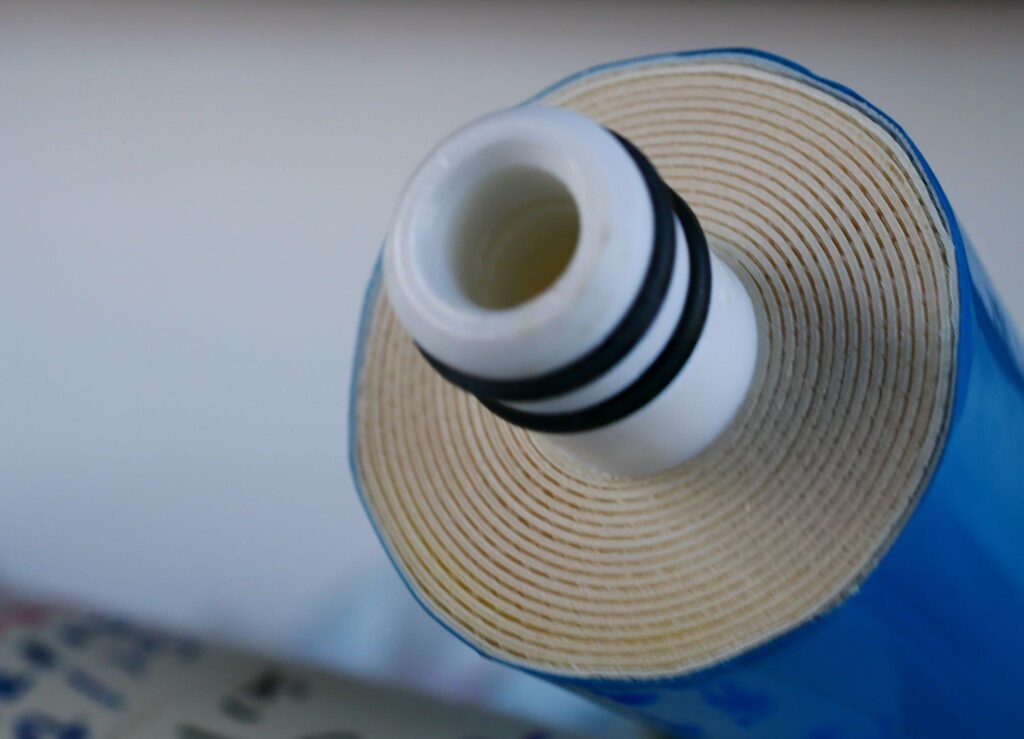
Signs that it’s time to replace your RO filter include a noticeable drop in water flow, a change in the taste or smell of the water, or if your user manual suggests it’s time for maintenance. These indicators can help ensure your system keeps running smoothly, regardless of household size or water consumption levels.
To be more precise about “when it’s time,” regularly monitor your system—monthly checks are ideal. Keep an eye on how much water you’re using because higher usage typically means shorter filter life. Setting reminders or marking your calendar can be a handy way to remember when it’s time for a replacement.
Identifying Signs of a Worn-Out Reverse Osmosis Filter
Spotting a worn-out reverse osmosis (RO) filter involves a bit of keen observation. One big sign? If your once great-tasting water starts to taste off or you notice a drop in its flow rate. This often means the RO membrane—key in removing contaminants—is past its prime.

Other red flags include frequent system shutdowns or cloudy RO water, pointing to an old filter needing a swap.
Changes in Water Taste
If your once-delicious RO water starts to taste metallic or funky, it might be time for a filter replacement. Over time, reverse osmosis filters get saturated with contaminants, affecting the water quality. Noticing that things taste off is a clear sign your filters need changing.
Decreased Water Flow Rate
A drop in water flow can also hint at filter issues. Low water pressure or a high level of sediment and contaminants in the water supply can clog the filter, reducing its efficiency. Keeping an eye on water pressure and water quality helps ensure your RO system lasts longer.
Observable Contaminants
Regular filter changes depend on the level of contaminants your reverse osmosis system deals with. More contaminants in your water supply mean more frequent changes.
Observable contaminants like silt, sediment, chlorine, and other chemicals can clog or degrade reverse osmosis filters faster. Watching your water quality is key to knowing when it’s time for a new filter.
Maintenance Tips to Prolong the Life of Reverse Osmosis Filters
Want to keep those reverse osmosis filters working their best? Here are some friendly tips to maximize their lifespan.
Regular Filter Replacement: Swapping out old filters for new ones is crucial. This ensures you keep getting that top-notch, purified water while also extending the life of your system. Depending on your usage and water quality, aim to replace pre and post-filters every six to twelve months. The RO membrane, on the other hand, should be changed every two to three years.
Periodic System Check-Ups: Regular check-ups can help spot and fix minor issues before they become big problems. This not only keeps your system running smoothly but also prolongs the life of your reverse osmosis filters.
Cleaning the System: Regular cleaning is essential. Debris and particles can build up and damage the RO membrane, reducing filter efficiency. Preventative cleaning measures can significantly extend the life of your filters.
Combining these proactive steps—regular filter replacements, system check-ups, and cleaning—will help ensure your reverse osmosis filters last longer and continue to provide you with quality water.
Regular Cleaning
Regular cleaning is key to extending the lifespan of your reverse osmosis filters. The heart of your reverse osmosis system is the storage tank, where filtered water is held before you use it.
Keeping this tank clean is crucial for the overall functionality of your filtration system. Over time, contaminants and debris can build up, obstructing the filtration process and reducing the system’s longevity. Regular cleaning ensures your tank stays hygienic and debris-free, promoting optimal performance and prolonging the life of your reverse osmosis filters.
Timely Replacement of Components
Your reverse osmosis system has several components, and the reverse osmosis membrane is a critical part. This semi-permeable layer handles most of the contaminant removal.
Typically, the replace the RO membrane every two to three years, depending on water quality and usage patterns. Pre-filters and post-filters, which protect the RO membrane and eliminate any remaining impurities, require more frequent changes—usually every 6-12 months.
Regular filter replacements ensure water purity and extend the life of the RO membrane, keeping your system efficient and long-lasting. Monitor your components regularly and respond promptly to signs of wear to maintain high-quality purified water.
Professional Servicing
Professional servicing is essential for maintaining your reverse osmosis filters and extending their lifespan. The filtration system has multiple filter stages, each with a specific job in removing contaminants. This includes sediment pre-filters, carbon filters, and the crucial RO membrane.
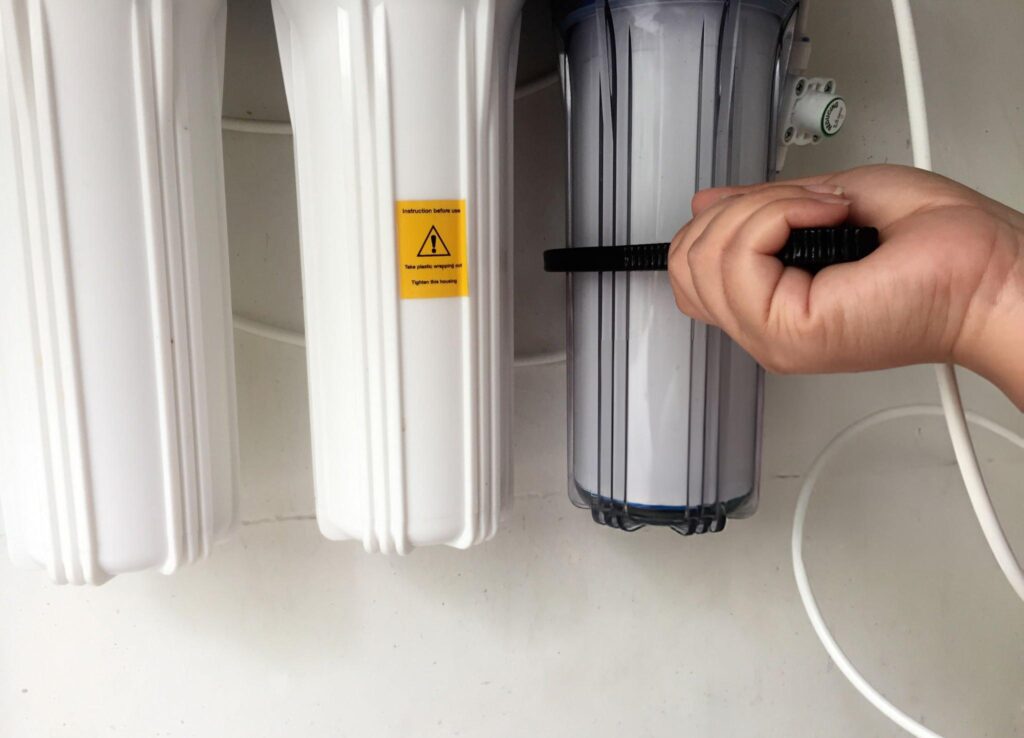
The lifespan of these filters varies, with pre-filters needing replacement every 6-12 months, carbon filters every 2-3 years, and the RO membrane every 2-3 years. The frequency of replacements depends heavily on water quality and usage. Regular professional servicing ensures each filter performs effectively and doesn’t shorten the lifespan of subsequent filters by underperforming.
Final Thoughts: Balancing Longevity and Functionality of Your Reverse Osmosis Filter
Let’s wrap up our water purification journey! Understanding how to balance the longevity and functionality of your reverse osmosis (RO) filter is crucial.
The main component of your RO unit is the RO membrane, the hero of the filtration process. This is the part that needs your attention because its effectiveness can decrease over time due to impurities. Typically, RO membranes last around 2-3 years, but factors like water quality, temperature, and usage patterns can affect this lifespan. That’s why proactive monitoring and regular check-ups are essential for optimal performance.
Replacing old filters with new ones is a game-changer. Not only does it extend the life of your RO unit, but it also boosts the efficiency of the water purification process. Regularly buying new filters ensures your unit stays in top shape, delivering safe drinking water.
To keep your RO unit running smoothly, adopt a solid maintenance schedule. This includes regular servicing, professional cleaning, and timely filter replacements.
